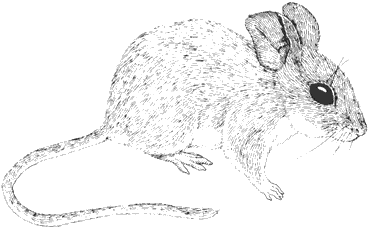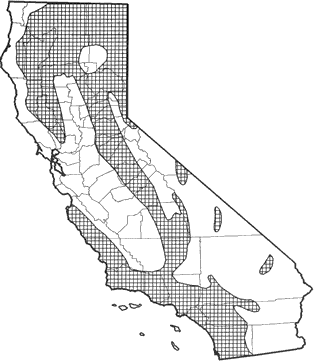
Brush Mouse
Distribution, Abundance, and Seasonality
The brush mouse occurs throughout California with the following exceptions: coastal region north of Monterey Bay, Central Valley grasslands, portions of the eastern Sierra Nevada, and the Mojave Desert. It is common to abundant in early to mid-seral stages of valley foothill hardwood, valley foothill hardwood-conifer, riparian, and chamise-redshank, mixed, and montane chaparral habitats. Less common in dense-canopy forest than in open-canopy forest. Elevational range from sea-level to over 3050 m (10,000 ft) (Jameson 1951, Baker 1968).

Range Map
Specific Habitat Requirements
Feeding: As other Peromyscus species, the brush mouse forages for seeds (especially acorns), fungi, and green vegetation, and feeds opportunistically on arthropods, especially insects in spring. Forages on ground, in shrub understory and in small tree canopy.
Cover: Prefers dense shrub cover for escape, feeding, and reproduction, and requires at least moderate shrub cover. Strongly associated with brush, slash, logs, rocks, and thick forest litter.
Reproduction: Grass nests are built in rock crevices, rotting logs, abandoned burrows, cavities in snags, or in the branches of shrubs (McCabe and Blanchard 1950, Jameson 1953, Brown 1964).
Water: Drinks under lab conditions. Under natural conditions, probably seeks water, but also obtains water from food and dew.
Pattern: Moderate to dense shrub canopy, with or without rock piles or rock outcrops, or in sparse understory with oak woodland overstory. Prefers mesic environments with abundant ground cover.
Species Life History
Activity Patterns: Nocturnal. Active above ground all year.
Seasonal Movements / Migration: None.
Home Range: In California, home ranges of males averaged 0.11 ha (0.27 ac), and varied from 0.02-0.38 ha (0.04-0.95 ac); female home ranges averaged 0.17 ha (0.41 ac), and varied from 0.02-0.65 ha (0.06-1.6 ac) (Storer et al. 1944). Densities of residents ranged from 2.0-17.3/ha (0.8-7.0/ac), and from 0.5-20.5/ha (0.2-8.3/ac) among nonresidents.
Territory: Females are territorial against other females during the breeding season.
Reproduction: Breeds from February through October, peaking in April to May and June to August; dates depend on amount of mast. Brush mice are solitary nesters. Gestation is 23 days for nonlactating females and 26-32 days for lactating females. Litter size averages 3 young (range 2-6). Probably 1-4 litters/yr. Females sexually mature on average at 51 days.
Niche: The brush mouse is an opportunistic granivore. Likely competitors are Peromyscus maniculatus, P. truei, and P. californicus. P. boylii probably is the most arboreal of these (Holbrook 1979). Predators include snakes, raptorial birds, and predatory mammals.
Sources & References
California Department of Fish and Game, 1999.
California's Wildlife, Sacramento, CA.
Written by: P. Brylski, reviewed by: H. Shellhammer, edited by: R. Duke
Baker, R. H. 1968. Habitats and distribution. Pages 98-126 in J. A. King, ed. Biology of Peromyscus (Rodentia). Am. Soc. Mammal. Special Publ. No. 2. Oklahoma State Univ., Stillwater. 593pp. Brown, L. N. 1964. Reproduction of the brush mouse and white-footed mouse in the central United States. Am. Midl. Nat. 72:226-240. Holbrook, S. J. 1979. Vegetational affinities, arboreal activity, and coexistence of three species of rodents. J. Mammal. 60:528-542. Jameson, E. W., Jr. 1951. Local distribution of white-footed mice, Peromyscus maniculatus and Peromyscus boylii, in the northern Sierra Nevada, California. J. Mammal. 32:197-203. Jameson, E. W., Jr. 1953 Reproduction of dder mice (Peromyscus maniculatus and Peromyscus boylii) in the Sierra Nevada, Calfornia. J. Mammal. 34:44-58. McCabe, T. T., and B. D. Blanchard. 1950. Three species of Peromyscus. Rood Assoc., Santa Barbara, Ca. 136pp. Storer, T. I., F. C. Evans, and F. G. Palmer. 1944. Some rodent populations in the Sierra Nevada of California. Ecol. Monogr. 14:166-192.
California Animal Facts | California's Wildlife